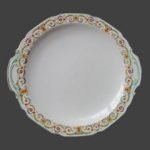Description
- Rosebud as box handle
- 7 cm height
- 7 cm diameter at it widest.
- Back Stamp used from 1902 to 1945
- Sorry of the photo – the colour is all the same, white. The lighting changed the colour!
The Sächsische Porzellan-Manufaktur Dresden GmbH (Saxon Porcelain Manufactory in Dresden Ltd), generally known in English as Dresden Porcelain (though that may also mean the much older and better-known Meissen porcelain), was a German company for the production of decorative and luxury porcelain. Founded in 1872, it was located in Potschappel, a suburb of the town of Freital in the Sächsische Schweiz-Osterzgebirge district about 8 km (5 mi) southwest of Dresden, the capital of Saxony.
The company has had a chequered history of ownership including its period as a nationalised VEB (People’s Owned Enterprise) in former East Germany. Russian businessman Armenak S. Agababyan owned 50% from 2005 to 2008 when he became sole owner,[1] and the company had been exporting 80% of its products. The main markets were the Russian, Asian and Arab regions.[1] In January 2020 Agababyan announced that production would cease indefinitely with two employees being retained to continue sales of stock from the showroom in the Carl-Thieme-Straße and the shop in Dresden until the end of 2020 when the company might be finally dissolved.
From the foundation in 1872 to 1945
Carl-Johann Gottlob Thieme (born 12 September 1823 in Niederjahna, died 18 March 1888 in Dresden) was a Hausmaler (a free-lance porcelain decorator). Thieme had been running his own porcelain studio and antique shop in the center of Dresden since 1864. He decided to manufacture his own porcelain and found a suitable plot of land at the gates of the city of Dresden in the industrial village of Potschappel. On September 17, 1872, Thieme’s Gründerzeit factory (now a listed cultural heritage monument) started operations. From the beginning, white porcelain was not only sold to the Dresden free-lance decorators, but also across Europe. Likewise, not only self-made, but also purchased white porcelain were painted and sold there.
The flower modeller Carl August Kuntzsch (1855–1920), a son-in-law of Thieme, played a key role in the company’s success. With the “lush flower covering”, he created a stylistic feature of Dresden porcelain. After Thieme’s death, he took over the company and the economic success in 1912 enabled extensions to the production buildings, which have remained unaltered to this day.[3] The world wars and the global economic crises reduced exports and the number of employees fell from 300 in 1914 to less than 70 in 1932.




